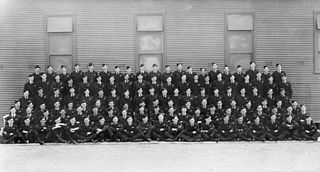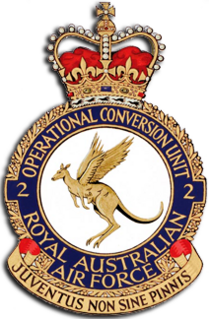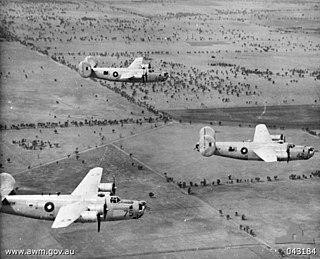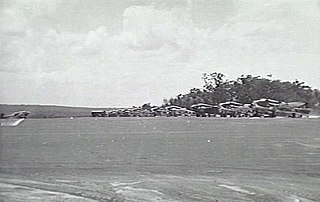This page is based on this
Wikipedia article Text is available under the
CC BY-SA 4.0 license; additional terms may apply.
Images, videos and audio are available under their respective licenses.

No. 1 Operational Training Unit (No. 1 OTU) was an operational conversion unit of the Royal Australian Air Force (RAAF) during World War II. Formed in December 1941 at Nhill, Victoria, it relocated to Bairnsdale in mid-1942, and then to East Sale the following year. No. 1 OTU's primary role was to train aircrew for multi-engined aircraft operations. At its peak of activity in August 1944, it was operating over 130 aircraft, the most numerous being Bristol Beauforts. Its aircraft and personnel also conducted transport missions in New Guinea and maritime patrols in southern Australian waters. Following the end of hostilities, the unit was disbanded in December 1945.

No. 2 Operational Conversion Unit is a fighter training unit of the Royal Australian Air Force (RAAF). Located at RAAF Base Williamtown, New South Wales, the unit trains pilots to operate the McDonnell Douglas F/A-18 Hornet, conducts refresher courses for pilots returning to the type, and trains future Hornet instructors. Pilots new to the Hornet enter No. 2 OCU after first qualifying to fly fast jets at No. 79 Squadron and undertaking initial fighter combat instruction at No. 76 Squadron. Once qualified on the F/A-18, they are posted to one of No. 81 Wing's operational Hornet units, No. 3 Squadron, No. 75 Squadron or No. 77 Squadron.

No. 3 Operational Training Unit (3OTU) was the Royal Australian Air Force's main seaplane training unit during World War II.

RAAF Station Tocumwal was a major Royal Australian Air Force base during World War II.

Bairnsdale Airport is located 4 nautical miles south west of Bairnsdale, Victoria, Australia, off the Princes Highway.

Nhill Airport is located 1 nautical mile northwest of Nhill, Victoria, Australia, about four hours northwest of Melbourne. The Nhill Aviation Heritage Centre is located there.

No. 7 Operational Training Unit RAAF (7OTU) was a Royal Australian Air Force heavy bomber training unit of World War II. 7OTU was formed on 12 February 1944 at RAAF Station Tocumwal in southern New South Wales to train RAAF B-24 Liberator crews. 7OTU was initially equipped with ex-USAAF B-24Bs but later received new B-24Js. At full strength the unit was equipped with 54 B-24s and was responsible for training 28 crews per month. 7OTU was disbanded following the end of the war.

No. 6 Operational Training Unit was a Royal Australian Air Force training unit of World War II. 6 OTU was formed at RAAF Base Nowra on 5 June 1943 to provide DAP Beaufort aircrew with training in torpedo dropping procedures and tactics.

No. 5 Operational Training Unit was an operational training unit (OTU) of the Royal Australian Air Force. It was formed at Wagga Wagga, New South Wales, in October 1942 to train pilots and navigators for service in World War II. The unit was initially equipped with Bristol Beauforts and Beaufighters, and later received Douglas Bostons and de Havilland Mosquitos, among other types. No. 5 OTU was transferred to Tocumwal in October 1943, and then to Williamtown in mid-1944. It was reorganised as a fighter conversion unit flying P-51 Mustangs and CAC Wirraways in February 1946, and disbanded in July 1947.
RAAF Bradfield Park was a Royal Australian Air Force (RAAF) station located at the former suburb of Bradfield Park during World War II.

No. 4 Operational Training Unit was an operational conversion unit of the Royal Australian Air Force during World War II. It was formed at Williamtown, New South Wales, in October 1942 to train pilots and wireless air gunners to operate Vultee Vengeance dive bombers. The school was equipped with Vengeances and CAC Wirraway aircraft. Accidents were common in operational conversion units, and No. 4 OTU suffered several fatal crashes during its existence. It was disbanded in April 1944, handing Williamtown over to No. 5 Operational Training Unit.

No. 5 Elementary Flying Training School was a Royal Australian Air Force (RAAF) pilot training unit that operated during World War II. It was one of twelve elementary flying training schools employed by the RAAF to provide introductory flight instruction to new pilots as part of Australia's contribution to the Empire Air Training Scheme. No. 5 EFTS was established in June 1940 at Narromine, New South Wales, and primarily operated Tiger Moths. It ceased training in June 1944, after more than 3,700 students had passed through.

No. 1 Operational Conversion Unit (No. 1 OCU) was an operational training unit of the Royal Australian Air Force (RAAF). Formed in January 1959 at RAAF Base Amberley, Queensland, its role was to convert pilots and navigators to the English Electric Canberra bombers flown by Nos. 1, 2 and 6 Squadrons. The unit's complement of Canberras included T.4 and Mk.21 dual-control trainers, and Mk.20 bombers. Originally a component of No. 82 Wing, No. 1 OCU became an independent unit at Amberley in April 1968, its focus being the provision of operationally ready pilots for service with No. 2 Squadron in the Vietnam War. No. 1 OCU was disbanded in June 1971, following the withdrawal of No. 2 Squadron from South-East Asia. By then the RAAF's only Canberra unit, No. 2 Squadron ran its own conversion courses before disbanding in 1982.

No. 2 Elementary Flying Training School was a Royal Australian Air Force (RAAF) pilot training unit that operated during World War II. It was one of twelve elementary flying training schools employed by the RAAF to provide introductory flight instruction to new pilots as part of Australia's contribution to the Empire Air Training Scheme. No. 2 EFTS was established in November 1939 as No. 3 Flying Training School at Archerfield, Queensland, and partially utilised aircraft and facilities of the civilian air training organisations based there. The school was renamed No. 2 EFTS in January 1940. It was disbanded in March 1942, and its operations transferred to No. 5 Elementary Flying School at Narromine, New South Wales, and No. 11 Elementary Flying School at Benalla, Victoria.

Southern Area Command was one of several geographically based commands raised by the Royal Australian Air Force (RAAF) during World War II. It was formed in March 1940, and initially controlled units located in Victoria, Tasmania, South Australia and southern New South Wales. Headquartered in Melbourne, Southern Area Command was responsible for air defence, aerial reconnaissance and protection of the sea lanes within its boundaries. From 1942 its operational responsibilities excluded New South Wales.














